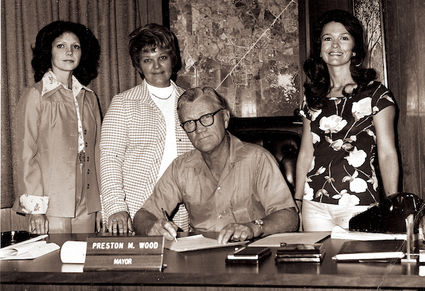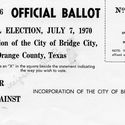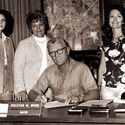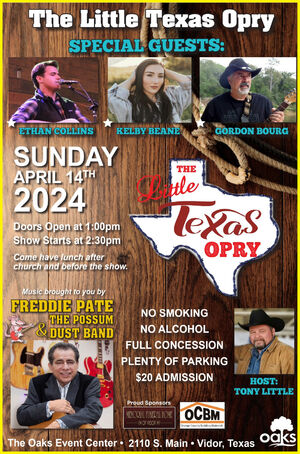BC marks another incorporation ‘birthday’
Last updated 7/4/2017 at Noon
Photo:
On Sept. 22, 1970, Bridge City held it’s first city election. Preston M. “Red” Wood narrowly edged out Jay Eshbach by three votes to become Bridge City’s first mayor. Seen with the new mayor are Jo Bernard, Gay Bell, Mayor Wood and Chris Heath.
For The Record
Stuck between two ports and their homeplace.
That’s where the 6,000 citizens of Bridge City found themselves 47 years ago.
Until there was, officially, a City of Bridge City.
Friday, July 7, marks 47 years since homeowners in that stretch of Southeast Texas between port cities Port Arthur and Orange chose incorporation (by a 677-466 vote) as the City of Bridge City on July 7, 1970.
“If the city would not have incorporated, they could have cut the town in half and Orange would have gotten a portion and Port Arthur a portion,” Charlotte Schexnider-Chiasson said.
“That would have been a nightmare for the town. How do you live on one street in one town and on the next one in a different city? Especially with Port Arthur and Orange being so far away?”
Chiasson wrote the book on Bridge City history – literally.
Her coffee table book, “The History of Prairie View-Bridge City,” released last fall, is available through the Bridge City Public Library, 105 Parkside Dr., with proceeds going to the Friends of the Bridge City Library to complete an addition on the library.
“The citizens wanted their say, no different than any other small town being incorporated,” Chiasson said. “You have to have some order for your town.
“Plus, we had no say-so, not when the county says what you can do and the Sheriff’s Office takes care of you.”
The first settlement located in the southeast corner of Orange County was called Prairie View.
The community wasn’t known as Bridge City until 1941, the name coming after the construction of the Rainbow Bridge over the Neches River in 1938 and the Cow Bayou Swing Bridge at the eastern end of Texas Avenue in 1940.
Chiasson said that name was suggested first for the school district by members of a local quilting club. First, there was the Bridge City school district, then Bridge City.
In the early 1960s, Gulf States Utilities built a massive power plant on the east side of the Neches, near Bridge City. Its 645-acre site produced enough electricity to power a 350-mile swath of east Texas and west Louisiana.
Orange and Port Arthur became embroiled in legal squabbles that centered on tax revenue generated by the GSU plant. Port Arthur had previously annexed land that the plant sat on and Orange announced a plan to annex land beyond the mouth of the Sabine River all the way to Lake Sabine to benefit from future industrial development.
Bridge City was caught in the middle. Annexation of the town seemed inevitable.
After the establishment of the Bridge City Chamber of Commerce in 1959, the push for incorporation began.
“It was mostly a matter of pride,” said H.D. Pate, longtime Bridge City attorney who, with fellow attorney Feagin Windham, filed the lawsuit that led the way.
“We had to keep our identity, keep the pride of ‘You’re in your hometown,’” Pate said. “And we were in our hometown, and we’re still in our hometown.”
But it was hardly a done deal.
“Some people wanted to live in a rural community where they could have a cow and a horse and chickens in the backyard, so it [incorporation] didn’t go through the first time,” Chiasson said.
“Plus, they didn’t want any more taxes. That’s why they moved there. That’s why my dad moved from Groves to there.”
In 1961, two elections were held for incorporation.
Both failed.
The Citizens for Bridge City Incorporation 1970 had a different outcome.
“We had a good group of civic-minded people and businesses that wanted to incorporate Bridge City,” C.W. “Bubba” Hubbard, founder of Hubbard Electric Company, told the Record before his 2005 death.
He and schools administrator Albert Gore co-chaired the 1970 citizens group that included 14 community leaders. They came from a wide spectrum of businesses and civic organizations and included John Brooks, Gus Garza, Curtis Lee, Donald Cole, L.J. Garriga, Charles Gorman, G.A. Laughlin, L.J. Bison and Tom Arnold.
Marjorie Fields served as the group’s secretary. Windham, an Orange attorney, and Pate, 27, a recent arrival from Austin, provided legal direction.
Pate and Windham readied the “C.W. Hubbard and Others” lawsuit, its intent to stall annexation and force another election for incorporation.
It was served against Orange and Port Arthur on a backdrop of claims and counterclaims: GSU refused to pay any further taxes to the city of Orange and Orange moved to block Port Arthur’s claims in Orange County.
The lawsuit created a roadblock to further legal action by Orange and Port Arthur. They released Bridge City from their territorial claims and settled with each other over the GSU squabble.
The citizen’s committee dropped its lawsuit. It was a victory.
But for the Citizens for Bridge City Incorporation 1970 it was a battle only half won.
Convincing the citizens to return to the polls one more time to vote for incorporation was the next obstacle.
“The procedure back then was that you needed at least 50 people to petition the Orange County Judge to hold an Election for Incorporation,” Pate recalled.
The citizens committee collected 160 signatures on its Application for Election to Incorporate, nine full pages, and permission for the election was granted.
Opposition to the proposal was a constant.
“As a high school student, I was probably not too in tune to politics,” said David Rutledge, Bridge City’s mayor. “The talk I remember was one party saying, ‘If we don’t incorporate, Port Arthur is going to swallow us whole.’ Nobody wanted that.
“The other side said, ‘No, they won’t come across the river.’”
The first incorporation election, on July 22, 1961, saw incorporation defeated 58 percent to 42 percent. Three months later, on Oct. 28, 1961, the naysayers ruled by a larger margin, 65 percent to 35 percent.
The Citizens for Bridge City Incorporation 1970 produced “An Open Letter to the People of Bridge City” that was published on the front page of The Penny Record.
Atop a front-page editorial endorsing incorporation, The Penny Record declared “Vote For A Bridge City” in bold red letters in the July 1, 1970 edition.
On election day, July 7, 1970, the ayes had it, by a margin of 60 percent to 40 percent.
One day after its big election victory, July 8, 1970, the Citizens For Bridge City Incorporation 1970 held the group’s final meeting.
On Sept. 22, 1970, Bridge City held its first city election. Preston M. “Red” Wood narrowly edged out Jay Eshbach by three votes to become Bridge City’s first mayor. The first city council consisted of Jack D. Pepper, Don Clayton, Charles English, E.T. Ernest and David Hock.
On Oct. 5, 1970, Bridge City’s first city council took the oath of office in a ceremony held at the Bridge City Volunteer Fire Department in a cinder block building at the corner of Bland and Roberts.
Pate was hired to be the city first full-time employee as city attorney, a position he held until 2004.
In 1973, Bridge City voters to accept a “Home Rule” charter that provided for a city manager.
For his involvement as a leader of the Citizens For Incorporation 1970, C.W. “Bubba” Hubbard was named the first Bridge City Chamber of Commerce “Citizen of the Year” in 1971. Pate was chamber president.



















Reader Comments(0)